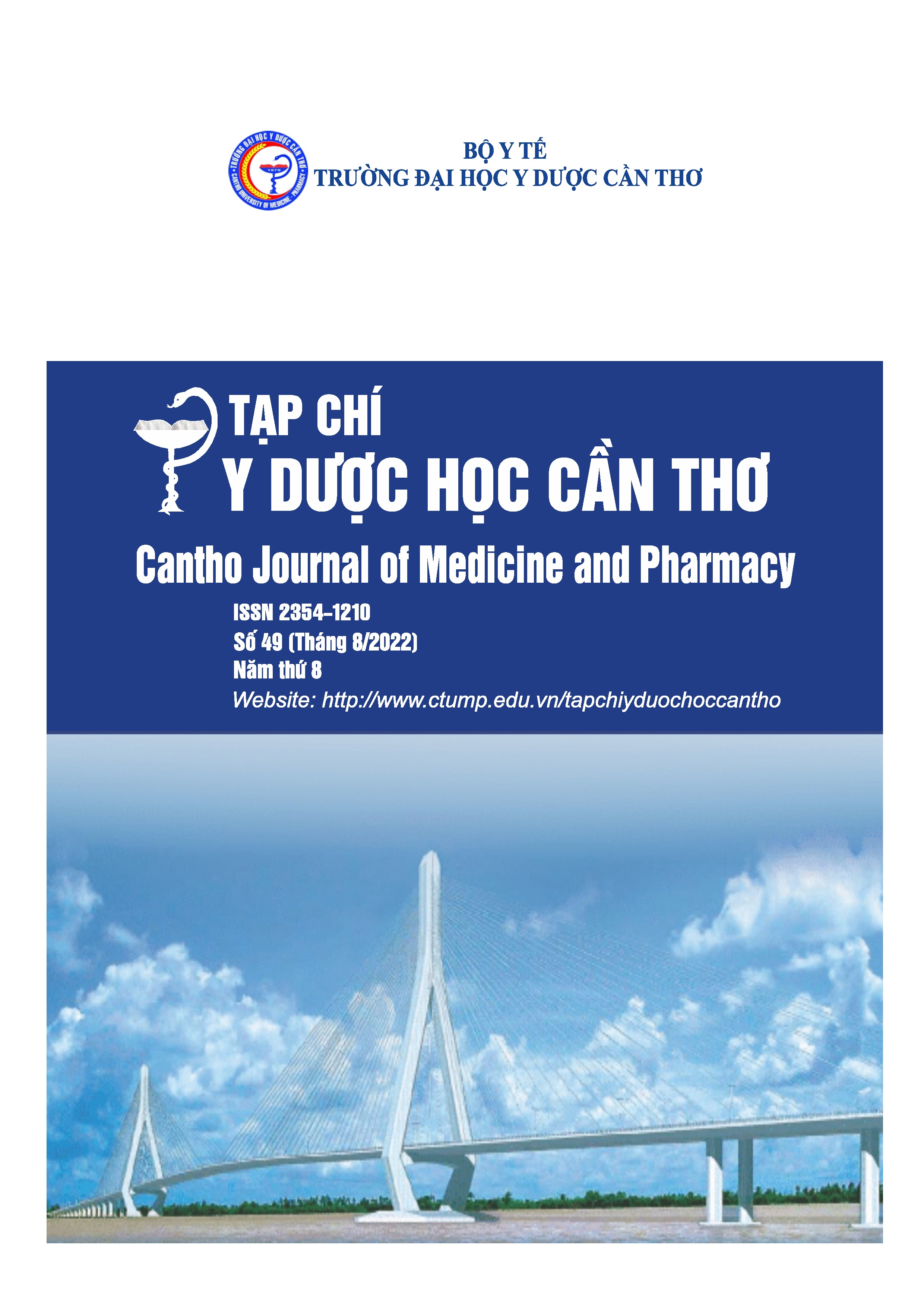STUDY ON CLINICAL AND SUBCLINICAL FEATURES ON SEVERE AND CRITICAL COVID-19 PATIENTS RECEIVING ADSORBENT DIALYSIS AT CAN THO GENERAL HOSPITAL
Main Article Content
Abstract
Background: The treatment of COVID-19 patients, especially severe and critical ill, remains a challenge for the limited health sector in the current context of our country. Therefore, relying on clinical signs and available tests to assess the severity and possibility of severe progression of the disease is essential to have a timely approach. Objectives: 1). To survey the clinical characteristics of severe and critical COVID-19 patients undergoing adsorbent dialysis; 2). To survey on laboratory characteristics of severe and critical COVID-19 patients undergoing adsorbent dialysis. Materials and methods: A cross-sectional descriptive study on 88 severe and critical COVID-19 patients receiving adsorbent dialysis from 7/2021 to 10/2021 at the ICU COVID19 Department of Can Tho General Hospital. Results: The mean age of the study group was 58.6±11.8. The oldest is 91 years old, the youngest is 24 years old. The male proportion accounted for 39.8%, the female accounted for 60.2%. 100% of patients had dyspnea. Other symptoms: fever accounted for 58%, dry cough accounted for 46%, loss of taste accounted for 34%, loss of sense of smell accounted for 28%. The temperature is 37.3±0.6°C; breathing rate is 27.5±4.6bpm; average blood pressure is 75.9±12.4mmHg; pulse is 102.9±15.4bpm, SpO2 is 92.1±3.5%. Test results: PaO2 75.4±22.9mmHg; PaO2/FiO2 168.7±82.3; CRP 8.7±5.2mg/dl; ferritin 795.6±484.3ng/mL; LDH 395.0±199.7U/L; D-dimer 802,3 (50,0-13189,0)mcg/L; Neutrophil/lymphocyte ratio 11.5±9.2; BUN/creatinine ratio 72.9±60.4; potassium 3.56±0.6mmol/L; AST 63.36±55.1U/L, ALT 60.15±46.8U/L. Conclusion: The most common symptoms in severe and critical COVID-19 patients are dyspnea, fever, and fatigue. All of patients had dyspnea. There is an association between pulse, serum LDH levels with mortality from COVID-19.
Article Details
Keywords
Clinical, LDH, pulse, COVID-19, severe and critical patients
References
2. Nguyễn Trung Nguyên (2021), “Nhận xét kết quả lọc máu hấp phụ cytokine bằng quả lọc resin ở người bệnh COVID-19 nặng tại Trung tâm Hồi sức tích cực COVID-19 thuộc Bệnh viện Bạch Mai, Kỷ yếu hội nghị khoa học toàn quốc lần thứ 21: COVID-19 những bài học kinh nghiệm, tr. 345-348.
3. Alavi Darazam I, Kazempour M, Pourhoseingholi MA, et al. (2022), “Efficacy of Hemoperfusion in Severe and Critical Cases of COVID-19”, Blood purification, pp.1-9.
4. Bonanad C, García-Blas S, Tarazona-Santabalbina F, et al. (2020), “The Effect of Age on Mortality in Patients with COVID-19: A Meta-Analysis with 611,583 Subjects”, Jamda-The Society for Post-Acute and Long-Term Care Medicine, 21(7), pp.915-918.
5. Cron RQ, Caricchio R, Chatham, et al. (2021), “Calming the cytokine storm in COVID-19”, Nature medicine, 27(10), pp.1674-1675.
6. Del Valle DM, Kim-Schulze S, Huang HH, et al. (2020), “An inflammatory cytokine signature predicts COVID-19 severity and survival”, Nat Med, 26(10), pp.1636-1643.
7. Griffith DM, Sharma G, Holliday CS, et al. (2020), “Men and COVID-19: A Biopsychosocial Approach to Understanding Sex Differences in Mortality and Recommendations for Practice and Policy Interventions”, Prev Chronic Dis, 17, E63.
8. Henry BM, Aggarwal G, Wong J, et al. (2020), “Lactate dehydrogenase levels predict coronavirus disease 2019 (COVID-19) severity and mortality: A pooled analysis”, Am J Emerg Med, 38(9), pp.1722-1726.
9. NICE (2020), “Cytokine adsorption devices for treating respiratory failure in people with COVID-19”, Medtech innovation briefing (MIB217), England.
10. Purohit D, Ahirwar AK, Sakarde A, et al. (2021), “COVID-19 and lung pathologies”, Hormone molecular biology and clinical investigation, 42(4), pp.435-443.
11. Quah P, Li A, Phua J, et al. (2020), “Mortality rates of patients with COVID-19 in the intensive care unit: a systematic review of the emerging literature”, Critical care (London, England), 24(1), pp.285.
12. Santos REA, da Silva MG, do Monte Silva MCB, et al. (2021), “Onset and duration of symptoms of loss of smell/taste in patients with COVID-19: A systematic review”, Am J Otolaryngol, 42(2), e102889.
13. Tang Y, Liu J, Zhang D, et al. (2020), “Cytokine Storm in COVID-19: The Current Evidence and Treatment Strategies”, Front Immunol, 11, e1708.
14. Who (2021), Viet Nam COVID-19 Situation Report 73, [cited 2022 Jan 10], Available from: URL:https://www.who.int/vietnam/internal-publications-detail/COVID-19-in-viet-namsituation-report-73.
15. Zhao Z, Chen A, Hou W, et al. (2020), “Prediction model and risk scores of ICU admission and mortality in COVID-19”, PLoS ONE, 15(7), e0236618.


